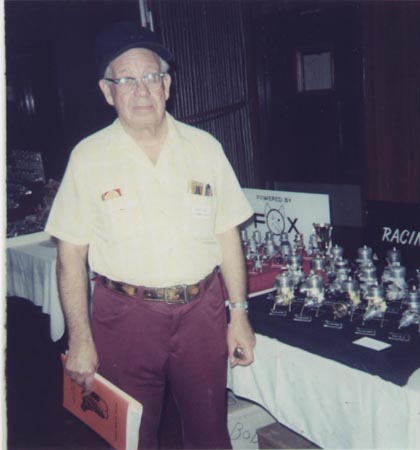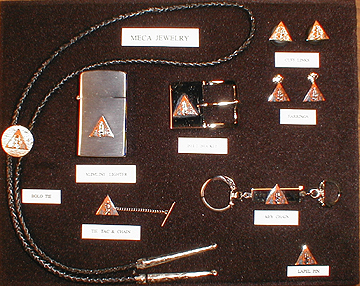
Small internal combustion engines have been around for a long time. In the US they date back to at least the early 1900s. The first ones were fairly crude and best suited for use as marine or stationary power plants. They were often built by their owners or by one of hundreds of small companies, many of whose advertisements were often on the optimistic side of reality. Prior to this the only other real choice for power was rubber bands, steam or hot air (Stirling Cycle) engines although there were examples that used materials like carbide or even gunpowder for fuel.
In the 1930s, William Lykens (Bill) Brown IV of Philadelphia, PA Developed the first small engine suited for powering model planes. Several models of this .60 cubic inch displacement "Brown Jr." engine were produced over the next 10 years or so with over 50,000 being made. These engines used an ignition system similar to that found on automobiles of the era, which meant that a model must carry a spark coil, condenser and batteries along with a fuel supply for its engine. Many of the original Brown engines are still in use and are sought after by engine collectors and modelers who still use them to power their models. Since then, there have been model engine companies with production figures running into the millions of units.
The little power plants that we collect were for the most part intended to power model planes, cars or boats. They come in many sizes and configurations with most of them being 2-stroke one cylinder engines ranging in size from less than .01 to several cubic inches in displacement. The majority of them (at least in the US) use a spark plug or a glow plug for ignition but there are also diesels, various types of jet engines and some little power plants that are powered by compressed air or carbon dioxide carried in a small storage tank.
MECA had its beginnings in the mid 1950s when Bruce Underwood, who may well be known better for his "Yellow Jacket" engines, started circulating a newsletter among a few friends who were interested in preserving the spark plug ignition engines that were rapidly disappearing due to the introduction of the Glow Plug by Ray Arden.

Bruce Underwood
Bruce acted as the focal point for gathering information for the engine collectors that were known at the time. He kept track of what each collector wanted and had to offer in exchange. He also suggested systems for marking and cataloging engine collections. The group grew to about 17 members.
In January 1960, the groups members were asked to submit names for the organization. Bruce suggested the winning name. MODEL ENGINE COLLECTORS ASSOCIATION (MECA) was adopted as the groups name the following month.
Starting in 1960, Joe Wagner took over MECA when Bruce had to step down due to his workload. During the 1960-1961 period Joe produced the four "Model Engine Collector" newsletters which were called "The Official Journal of the Model Engine Collectors Association" and the "Index of American Model Engines" which listed over 700 engines known at the time. This material is considered to be the first volume of what is now the "Engine Collectors' Journal" (ECJ) which was to begin publication in 1963 and is still being published by Tim Dannels. The first MECA officers were named during this period. The membership at this time probably reached 25-30 people.
In 1963 Allen Shively took over and started reviving MECA which had become nearly inactive. During 1963 and the first half of 1964 The first issues of the ECJ became the "Voice of MECA" through Allen's "MECA NOTES" column. By May 1964 MECA membership had reached 115, the country had been divided into 11 MECA regions and the first Regional Directors were selected.
The first MECA BULLETIN was published by Allen in March 1964. This publication contained MECA club related information and a schedule of upcoming events as well as reports on past events and information that would be useful to those wanting to repair and/or restore their engines. The earliest MECA Bulletins also contained lists of items wanted & available for sale or trade by MECA members. In 1964, this list was moved to a separate publication.
The first MECA SWAP SHEET was published in March 1968 by then national coordinator Karl Carlson. It listed engines and parts wanted and/or available for sale or trade by MECA members as well as other hobby related information.
In late 1968 a design for the MECA logo which was selected from a entry submitted by Ben Fox appeared on the cover of MECA Bulletin #23.
In February 1969 the name "Collectogether" (usually shortened to "Collecto") was coined by Jim Dunkin at an engine swap meet taking place at his home.
Over the years, MECA members discovered that socializing had become an important part of the engine collecting experience. In mid 1972 Tim Dannels had a line of MECA logo jewelry made up which was offered for sale to MECA members.

The first National Collectogether, which was arranged by The Society of Antique Modelers (SAM), was held at the 1971 SAM CHAMPS in Denver, Colorado. Later this was to be called the "Grand National Collectogether" which was promptly shortened to "GRANDO". SAM continued to help arrange the GRANDO event for many years.
In 2000, MECA decided to take over all aspects of holding the National Collectogether. This new event is called "EXPO"
EXPO is much more than a collecto, it has been expanded over several days to include symposiums, guest speakers, a banquet with entertainment, functions for the ladies and in some cases a contest.
EXPO is currently held the weekend just prior to the SAMCHAMPS in years when the SAMCHAMPS take place in Muncie, Indiana. On alternating years, EXPO will also take place in Muncie on a date that will allow MECA and SAM members to attend both events. In these years EXPO will be followed by the MECA sponsored MIDWEST CHAMPS contest.
In July 2000, MECA was adopted by The ACADEMY of MODEL AERONAUTICS (AMA) as a SIG (Special Interest Group).
In late 2002 the MECA BULLETIN and the MECA SWAP SHEET were combined into a single bi-monthly publication which typically is about 60 pages in length.
Time has not been kind to MECA. Since the 1990's membership has been in decline for a variety of reasons, some of which are.
Our membership is rapidly ageing and today's hobbyists are less inclined to take up the engine collecting hobby and/or join MECA. This trend is not limited to MECA as the popular stamp and coin collecting hobbies have also suffered from declining interest.
Communication has gone from mostly the U.S. Mail and long distance telephone calls to the Internet and cell phones.
On line auction sites such as Ebay where you can place an item for sale in a few minutes vs an ad in the MECA Swap Sheet which has a lead time of about a month. Since these sites are open to anyone, the opportunities to obtain or sell items far exceeds what is available through MECA channels. These sites can be very risky because unless the seller is a MECA member you may be out of luck should you want to return a purchase that you are dissatisfied with. MECA members who use these sites are expected to conduct themselves per MECA rules.
A lot of collectible engines both foreign and domestic and much historical and restoration information about them is now available through websites.
As a result of these and other factors the attendance at Collectos has declined to the point that after EXPO XV in 2014, EXPO became a one day event now called the National Collecto.
Today MECA is worldwide with members in the US and over 20 foreign countries, some of which have become MECA Regions. Over 5000 people have joined MECA to date and over 400 of them are currently active.